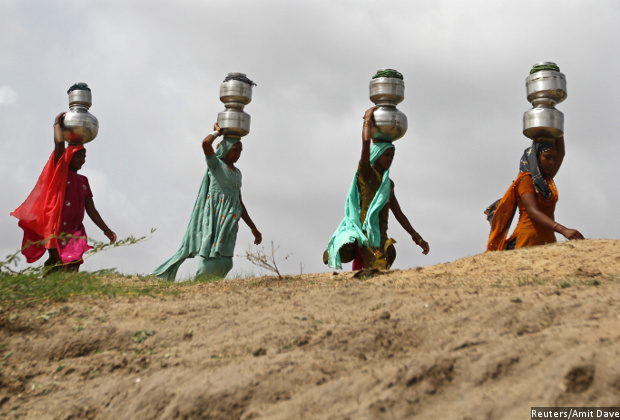The Great Indian Water Walkathon
More than half of Indian households did not have a source of drinking water at home--63% in rural India--and a fifth of rural households walked more than 500 m to get drinking water, according to 2011 Census data.
In Odisha, Jharkhand and Madhya Pradesh, more than 35% of rural households walk the 1/2-km distance.
Source: Census 2011
One in four rural households spends more than half an hour walking to a water source, according to the Indian Human Development Survey (IHDS II), which surveyed 42,153 Indian households.
Households in rural Odisha take the longest average walking time to reach a water source--more than an hour. In addition, they spend time waiting their turn. Once filled, water jugs can weigh as much as 20 kg.
The situation isn’t any brighter in urban areas: 20% of households spend more than half an hour reaching water sources.
In the summer, 36% of households across India take 30 min to a water source, up from 23% in other seasons.
Source: Indian Human Development Survey (IHDS II)
As water sources diminish, water becomes more unsafe
India is the largest groundwater user in the world with an estimated 230 cu km used every year, more than a quarter of global consumption.
The limited success of surface irrigation projects and cheap electricity for farmers using tube-wells has led to an over-reliance on groundwater and aquifers.
As groundwater levels plunge, millions of Indians are at risk of drinking contaminated water, IndiaSpend reported earlier.
A comparison of pre-monsoon groundwater level in the agricultural states of Punjab and Haryana shows that the percentage of wells with water deeper than 20 m has increased 40% in Haryana and 70% in Punjab between 2011 and 2015.
Source: Central Ground Water Board (CGWB), 2011, 2015
Quality of drinking water is compromised
With safe drinking water hard to access for so many, India loses as many as 73 million working days due to water-borne diseases, according to this 2016 report by the National Water Development Agency.
Bihar, Rajasthan and West Bengal are among the worst offenders, with more than 18% of rural population in these states unable to access quality drinking water, according to this National Sample Survey Organisation (NSSO) report, Key Indicators of Drinking Water, Sanitation, Hygiene and Housing Condition in India.
Socio-economic impact of time spent on walking to fetch drinking water
The effort to fetch drinking water slows development, including education, according to global studies by United Nations Development Programme (UNDP), United Nations Children's Fund (UNICEF) and Oxfam.
Being ‘needed at home’ is a major reason why children, especially girls from poor families, drop out of school.
Indian states with a lower human development index (HDI 2007-08) report a higher proportion of rural households without a drinking water source near or within the household and correspondingly longer average walking times for rural women to fetch drinking water.
Source: Indian Human Development Survey, (IHDS II), NITI Aayog - Population data, NITI Aayog - HDI data
A few bright spots
Close to 92% of the IHDS survey respondents reported having enough water through the year, although this figure falls to 80% in the summers.
More than 95% of urban respondents across India report having an ‘improved source of drinking water’, such as bottled water, piped water or tube well.
(Tewari is an analyst with IndiaSpend. Bapat is an intern with IndiaSpend.)
We welcome feedback. Please write to respond@indiaspend.org. We reserve the right to edit responses for language and grammar.
__________________________________________________________________
Liked this story? Indiaspend.org is a non-profit, and we depend on readers like you to drive our public-interest journalism efforts. Donate Rs 500; Rs 1,000, Rs 2,000.



